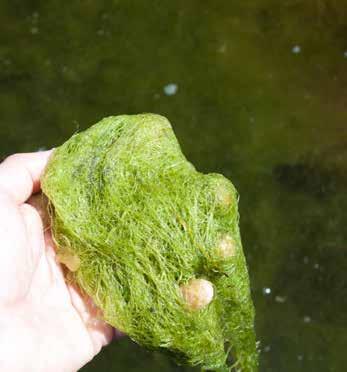
5 minute read
Restoring the Indian River Lagoon
Work continues to restore the estuary to its former glory.
BY KRIS MILLGATE
There are four estuaries of national significance in Florida. They are among 28 National Estuary Programs (NEPs) in the United States authorized under the federal Clean Water Act. NEPs are federally established, but locally managed, creating ideal collaborations for landscapes spanning multiple political jurisdictions.
The Indian River Lagoon, one of Florida’s four NEPs, is on the state’s eastern border. It dominates a long, skinny stretch of the Sunshine State next to the Atlantic Ocean.
“Indian River Lagoon is an integral part of our state’s natural resources because of what it supports, especially our fisheries,” says Kellie Ralston, Vice President for Conservation and Public Policy at Bonefish & Tarpon Trust. “The number of people that are focused on it and the caliber of people gives me hope. We are seeing incremental progress and we want to make sure we keep the momentum going so we can see it return to its glory.”
Indian River Lagoon’s biggest challenge is water quality. BTT’s Win Back Our Water campaign, launched in the fall of 2023, is responding to that challenge by addressing the overload of inputs from leaky septic systems, outdated sewage treatment facilities, and stormwater runoff, which are the main causes of Indian River Lagoon’s decline.
“The Win Back Our Water campaign has been very significant,” says Dr. Aaron Adams, BTT’s Director of Science and Conservation. “It has brought attention to issues not only in Indian River Lagoon, but statewide. It’s also raised awareness of the impact of contaminants and too many nutrients. Having science translated to layman’s terms helps people see how things affect their way of life.”

Wastewater Treatment
When BTT published its findings on pharmaceutical contaminants in fish, the response was tangible and immediate. Nearly all (94%) of sampled redfish in the lagoon had humanity’s flushed medication in their bodies. The statistic revealed that Florida’s decaying septic systems urgently need improvements and its sewage treatment plants require upgrades. Both cost money, a lot of money.
“We have made significant improvements through state and local funding,” says Dr. Duane De Freese, Executive Director of the Indian River Lagoon Council. “Brevard County puts in $50 million annually. The state puts in $100 million a year for water quality improvements. Those are historical levels of funding at local and state levels, but at the federal level it’s very modest.”
It takes billions of dollars to fix a landscape-sized problem with every community adding to the total progression. That’s why collaborative lagoon restoration efforts with local, state and federal partners under NEP designation is so important. Its council monitors dozens of projects across the watershed that hosts seven counties, 38 cities and 1.6 million residents.
“When you start to assemble these smaller projects and the impact they have on water quality and community, there’s a remarkable effort,” De Freese says. “It’s incredible what’s going on.”
Seagrass is rebounding in patches and algae blooms are in decline, but there’s still more to be done for a system that definitely has an inlet but not much of an outlet.
“There is no other estuary in North America that is quite like Indian River Lagoon,” De Freese says. “We are unique because we are narrow, shallow and microtidal so what you put in the estuary, tends to stay in the estuary.”

Stormwater
The other challenge highlighted by BTT’s Win Back Our Water campaign is runoff. It stays in the estuary just like the nutrients and contaminants from wastewater. Stormwater sounds benign, but it’s far from harmless because what’s in that runoff isn’t just rain. The 10,000 collection ponds in Indian River Lagoon contain residue, additives and chemicals, including glyphosate which is in 99 percent of the lagoon’s sampled fish, according to a study conducted by BTT partner Ocean Research & Conservation Association (ORCA).
“The lagoon has been in trouble for many years,” Adams says. “But a good sign of improvement is seeing seagrass in places we haven’t seen it grow in 10 years. Seeing that come back is significant. It’s great to have progress, but we still have a long way to go.”

When those 10,000 storm collection ponds are full, they release. Often times, like after a heavy storm, all the ponds discharge into the lagoon at the same time. Staggering their releases through a coordinated network could help reduce unwanted overload. That’s what’s next on the radar for Indian River Lagoon, and possibly other watersheds in the future.
“In Florida, it’s not often that something comes along that shows potential to change the way we approach water resource management,” says Greg Knecht, Executive Director of The Nature Conservancy’s Florida Chapter. “We’ve made significant strides around wastewater treatment, but stormwater has not really changed in 30 years. We’ve taken away how watersheds historically work. The intent is to put the watershed back into watershed. When we’re successful, this is transferrable across Florida and hopefully other states.”

Outdoor journalist Kris Millgate is based in Idaho where she runs trail, hunts birds and chases trout. When she’s on the coast, she likes casting to bones and jacks. She followed salmon migration solo during the pandemic for the Emmy-nominated film Ocean to Idaho. Her new Emmy-winning film, On Grizzly Ground, is available now along with her third book My Place Among Beasts. See her work at www.tightlinemedia.com.








